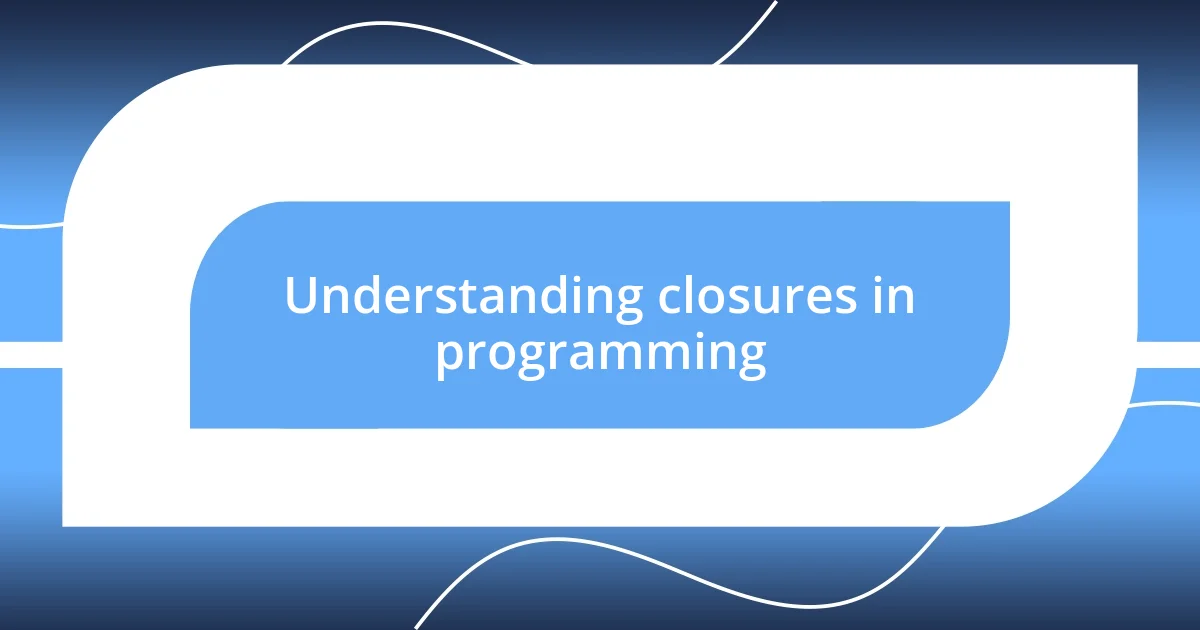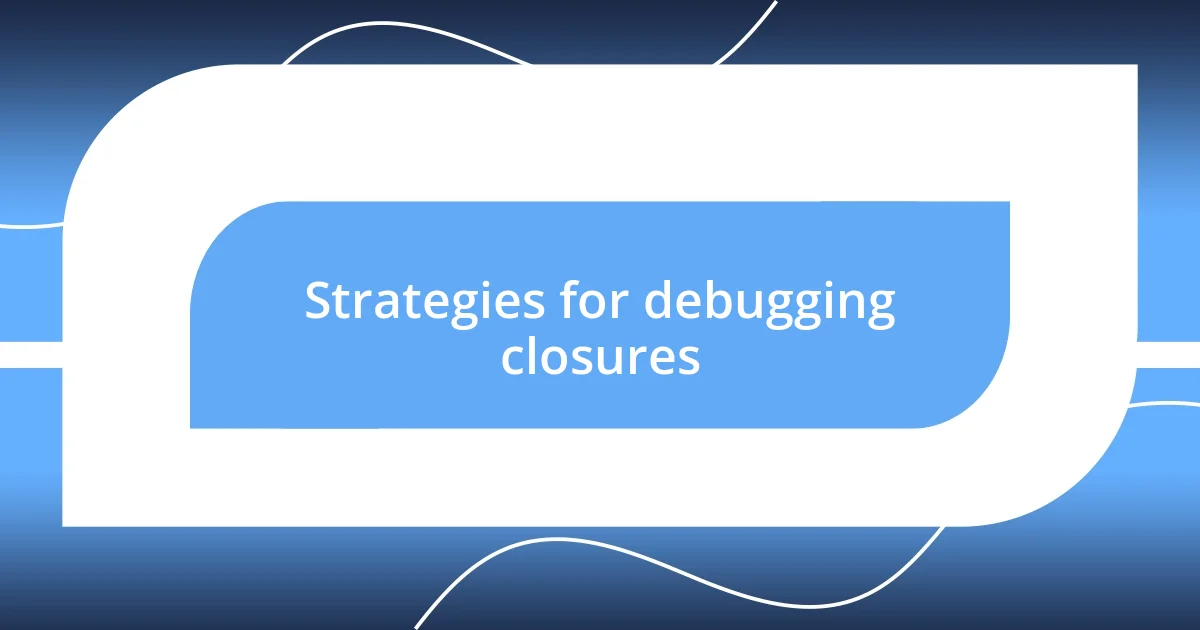Key takeaways:
- Closures capture variables from their lexical scope, preserving their context even outside the original function, which can lead to powerful encapsulation but also introduces debugging challenges.
- Common challenges with closures include misunderstanding scope, maintaining state across invocations, and the complexity of debugging, often likened to solving a mystery.
- Effective strategies for managing closures include clear variable naming, isolating logic into smaller functions, and using tools like console logging, linters, and visualization tools to enhance understanding and simplify debugging.

Understanding closures in programming
Understanding closures in programming can feel like peeling back the layers of an onion. When I first encountered closures in JavaScript, I was both fascinated and perplexed. It’s that moment when a function retains access to its lexical scope, even when that function is executed outside of its original context. Have you ever experienced that rush of discovery when everything clicks into place?
I remember a particular late-night coding session, struggling with a closure that held on to a variable despite my attempts to change it. It was an “aha” moment when I realized closures allow functions to capture variables from their surroundings, creating a powerful encapsulation of the state. I felt a bit like a magician revealing the secrets of my own tricks; it opened my eyes to the beauty of functional programming.
It’s essential to grasp that closures are not just about encapsulating variables; they’re about preserving that context. Think of a closure as a time capsule for your function’s environment. When you write code that relies on closures, you’re essentially crafting a miniature world where your variables can live on even after the initial function has completed. Have you ever built something that just worked seamlessly? That’s the kind of joy closures can bring to your programming experience.

Common challenges with closures
When it comes to closures, one of the most common challenges I faced was understanding scope. A closure is tightly linked to the scope of variables, and mistakes in scope can lead to bugs that seem to appear out of nowhere. I vividly recall debugging a loop where I intended to capture the value of a variable, but I instead captured the final value due to how closures were created within that loop. It was frustrating, but it taught me the importance of being mindful of where and how I create my functions.
Another challenge often stems from maintaining state across different invocations of the closure. For instance, I worked on a project where a closure was supposed to track user counts but ended up always resetting. It turned out I had not set up the closure to preserve its state correctly. Realizing this was a turning point because it highlighted how critical it is to manage your closures’ context intentionally.
Lastly, debugging closures can sometimes feel like trying to find a needle in a haystack. When you understand that these functions can retain state, tracking down which closure is misbehaving can be like solving a mystery. I remember one instance where I spent hours figuring out a seemingly unrelated bug in my application that was ultimately traced back to a closure I had forgotten was in use. That experience taught me the value of clear documentation and comprehensive testing strategies.
| Challenge | Description |
|---|---|
| Scope Misunderstanding | Problems arise when closures capture variables in unexpected ways, especially within loops. |
| State Management | Maintaining the state across function calls can lead to bugs when not done correctly. |
| Debugging Complexity | Finding the source of an issue can be difficult due to closures holding onto their environment. |

Strategies for debugging closures
When it comes to debugging closures, I often turn to a few practical strategies that have saved me countless hours of frustration. One effective approach is to use console logging generously. I remember a time when I was grappling with an especially tricky closure. By logging the variable states at different points in my code, I was able to trace where things were going awry, almost like following breadcrumbs back to the source of the issue. This method not only clarified the flow of my program but also aided in understanding how and when variables were being captured.
Here are some strategies I find particularly helpful:
- Use console.log: Trace variable states at different points to see when and how they change.
- Isolate logic into smaller functions: This enhances readability and makes it easier to identify where closures are misbehaving.
- Leverage debugging tools: Tools like Chrome DevTools allow you to set breakpoints, helping you step through your code to see the closure’s behavior in real-time.
- Write tests: Unit testing functions that use closures can help catch issues early on, providing a safety net as you modify your code.
I cannot stress enough the difference that small, focused tests made during a project where I was tracking user interactions. By isolating each functional area, I avoided the chaos that often comes with complex, nested closures. This method helped me regain control over my code, which felt empowering and inspiring. Debugging closures, while challenging, becomes manageable with the right strategies in place.

Using tools for debugging
Using the right tools for debugging can really transform your experience when tackling complex closures. I’ve found that leveraging browser developer tools, like Chrome DevTools, has been invaluable. One time, I was stuck on a particularly messy closure that handled async calls. By setting breakpoints and stepping through my code, I could watch the closures in action, which not only gave me clarity but also made the debugging process feel more like an engaging puzzle than a frustrating chore.
Another tool I swear by is linters, such as ESLint. I remember when I implemented it for a project with deeply nested closures that had inconsistent behavior. The linter flagged potential issues before I even ran the code. Isn’t it fascinating how a simple tool can help catch problems that might fly under the radar otherwise? It feels reassuring to know there’s an extra set of eyes analyzing your code for common pitfalls, especially when closures are involved.
Finally, I’ve started to appreciate the power of visualization tools, which help in representing function scopes and closures graphically. During one project, I used a tool that illustrated how closures captured variable states. It was like shining a light on a dimly-lit room! Seeing the relationships clearly helped me understand intricate behaviors, revealing insights that made me rethink how I structured my code. Wouldn’t it be great if every complex coding challenge came with a visual aid? These techniques collectively enhance the debugging experience and enable a clearer, more efficient approach when dealing with closures.

Analyzing closure behavior with examples
Analyzing closure behavior can sometimes feel like peering into a maze. I recall an instance when I was wrestling with a particularly convoluted closure. I decided to create a small demo project, isolating the closure’s components. By doing this, I was able to follow how the variables were captured and used. It was enlightening! I could literally see the paths taken by the closures, which made their behavior much clearer to me.
Another example that stands out is when I faced unpredictable outputs from a closure that modified outside variables. I was frustrated at first, but then I wrote down every step in a flowchart format. It helped me visualize which variables were affected at each function call. Suddenly, the “Ah-ha!” moment struck! This visual breakdown clarified how closures interacted with their surrounding scopes. Has something similar happened to you, where a simple shift in perspective changed everything?
I also remember a time when I misread how closures were capturing variables in a loop. At first, the output was not what I expected, which left me scratching my head. After a thorough examination, I added a dedicated console log for each iteration, giving me precise snapshots of the loop’s state. This minor adjustment brought to light the closure behavior I misinterpreted. I think it’s incredible how just a little more attention to detail can shed light on the complex interactions within our code, don’t you?

Best practices for managing closures
Managing closures effectively is key to avoiding headaches down the line. I often start by clearly naming variables in closures. This practice not only enhances readability but also reinforces the purpose behind each variable. I remember a time when I struggled to keep track of what each variable represented, leading to a cascading series of errors. It was frustrating! So, I learned that clear naming can transform closures from a jumbled mess into a more structured and understandable piece of code.
Another best practice I’ve adopted is to limit the scope of closures when possible. By ensuring that closures only access the variables they truly need, I reduce potential conflicts and enhance maintainability. For instance, in one project, I had a closure that accessed several elements from its surrounding scope. The result? A tangled web of dependencies that was difficult to debug. After simplifying it, I felt a huge weight lift off my shoulders. Have you ever noticed how streamlining your code can lead to quicker fixes?
Lastly, implementing documentation along the way is something I can’t stress enough. I make it a habit to annotate complex closures with comments explaining their purpose and structure. This was particularly helpful when working with a team, as I could provide context for my thought process. At one point, a teammate thanked me for my thorough comments during a code review, as they made it easier to jump in and contribute without needing a lengthy onboarding. Isn’t it rewarding when a little extra effort leads to such positive collaboration?

Lessons learned from debugging closures
Debugging closures has taught me that patience is truly a virtue. I remember a particular instance when I was knee-deep in tracking down an elusive bug caused by a closure retaining an outdated variable. I felt exasperated as my frustration mounted. However, by taking breaks and approaching the problem with fresh eyes, I began to notice patterns I had overlooked. It was a reminder that sometimes stepping away can help clear the mental fog.
Another lesson that resonated with me is the importance of understanding the execution context. One day, while debugging a nested closure, I felt like I was in a tangled knot of confusion. I took the time to map out the relationships and contexts of each function. When I finally saw how the closures interacted with their surrounding scopes, it was like flipping a light switch! Recognizing the environment in which closures operate can dramatically simplify the debugging process.
I often marvel at the power of small changes in my debugging approach. There was a time when adding a simple breakpoint completely altered my understanding of a tricky closure’s behavior. Watching the execution unfold in real-time revealed nuances I hadn’t anticipated. Have you ever found that making a minor tweak or adjustment led to clarity? It makes me appreciate how even the tiniest details can significantly impact the debugging experience!













